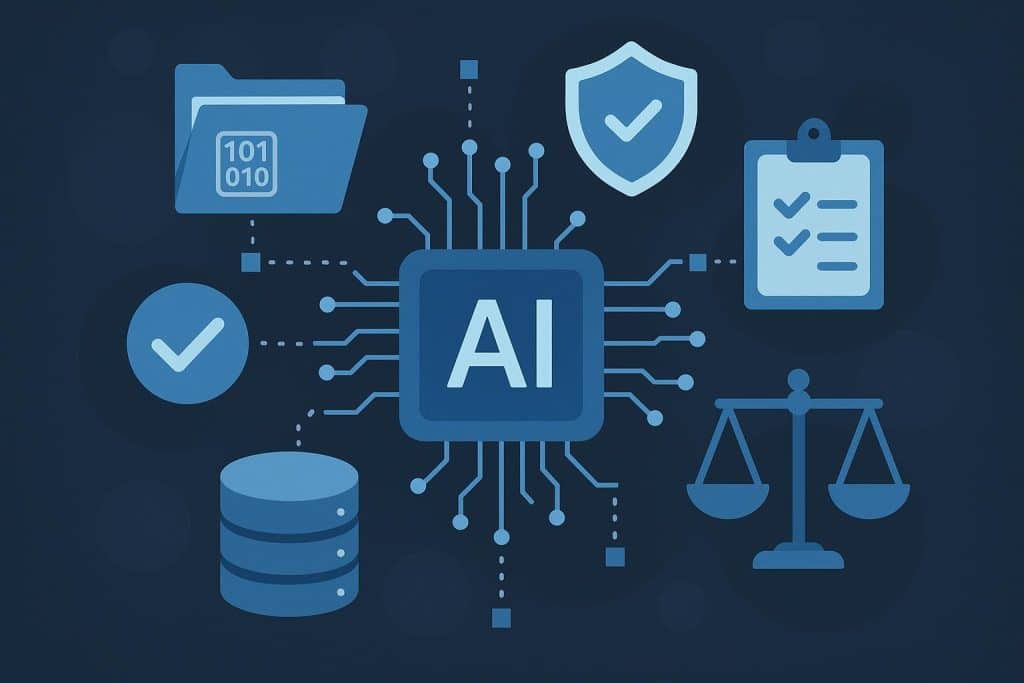If you think governance is optional, look at the bill. Regulators have issued more than €5.6 billion in GDPR fines as of March 1, 2025. CMS Law Data volumes are still climbing toward 181 zettabytes by the end of 2025, which makes manual control checks even harder to keep up with. Rivery And while the classic Ponemon study is older, its signal remains clear. Non-compliance costs can be almost three times the cost of staying compliant.This piece lays out a practical, operator’s view of AI-powered data governance. The goal is simple. Reduce friction. Catch issues early. Be ready for audits without heroic clean-ups. I’ll show where AI fits, what changes in your day-to-day, and how to roll it out without chaos.Governance bottlenecks inside enterprisesMost teams don’t suffer from a lack of policies. They struggle to turn policies into evidence at scale. These are the common choke points that I see:
Two outcomes stand out:
No. The value is execution. Tests run continuously and produce signed evidence. Dashboards are a side effect, not the end goal.Will auditors accept AI-generated evidence?
Auditors care about traceability, completeness, and control design. Continuous control tests and immutable logs support that. Healthcare and pharma guidance call for reliable audit trails and documented data integrity. The method you use to collect evidence is secondary to whether it is accurate and complete.How do we manage AI risk itself?
Use a recognized framework from the start. NIST AI RMF gives common language and structure for documentation, monitoring, and review.Where do we start if our stack is legacy?
Begin with a thin slice. Centralize logs for one high-risk process. Automate two or three controls. Prove the cycle works. Then expand as your data modernization services program moves workloads to a modern platform.
- Controls mapped on paper but not tied to systems. You can name the rule, but you can’t show where it runs.
- Evidence trapped in screenshots and spreadsheets. Auditors ask for lineage and you spend nights stitching files.
- Data lineage is partial. You know sources, not transformations, so root-cause takes days.
- Control testing is periodic. Risk moves in hours.
- Audit trails exist but are inconsistent across platforms. Healthcare regulations expect logging of access and activity. Many logs are incomplete or hard to query.
- Model governance is ad hoc. Financial institutions still depend on manual model validations for critical decisions. Guidance expects end-to-end governance, validation, and monitoring.
- Risk reporting aggregates slowly. Banking standards highlight timely risk data aggregation. Many firms still reconcile at month-end.
- Policy-to-control mapping
Use NLP to read policy text and map it to control families, procedures, and specific system checks. The output is a set of executable checks aligned to your framework. This aligns with modern governance platforms that integrate policy, catalog, metadata management, and control execution in one place. - Control testing without calendars
Continuous controls monitoring pulls logs, events, and configuration data and tests them in real time. Anomaly detection cuts through false positives and routes exceptions for review. Industry guidance supports the shift from point-in-time tests to continuous control oversight. - Lineage that explains itself
Graph models capture relationships among tables, pipelines, and dashboards. AI enriches the graph with business terms, owners, and quality signals. This is where active metadata management earns its keep, moving beyond passive catalogs to real-time context. - Quality that fixes itself
Modern data quality platforms use ML to learn patterns, detect drift, and propose fixes. Vendors and analysts call this augmented or automated data quality. The value is not a shiny dashboard. It is fewer broken metrics and fewer rollbacks. - Evidence that compiles on its own
As controls run, the platform assembles immutable evidence. It links a control to the data it touched, the tests it ran, and the outcome. That makes audit packets quick to export and easy to sample. - AI system risk mapped to business risk
If you deploy AI models, align monitoring and governance with established frameworks such as NIST AI RMF. Do not bolt this on later. Bake it into your control library from day one.
| Day-to-day task | Manual reality | With AI-powered governance |
|---|---|---|
| Control testing | Calendar-based sampling, heavy spreadsheets | Event-driven tests run continuously, exceptions only |
| Evidence for audits | Screenshots and emailed extracts | Auto-compiled artifacts with traceable lineage |
| Data quality | Reactive fixes, repeated incidents | Automated data quality rules learned and tuned over time |
| Lineage | Partial, out of date | Active graph with owners and impact analysis |
| AI model oversight | Irregular checks | Integrated drift checks and documentation mapped to NIST AI RMF |
| Reporting | End-of-month reconciliations | Streaming KPIs with thresholds and alerts |
- Fewer manual checks
- Real compliance monitoring
- Challenge: model risk, KYC, payments screening, and capital reporting.
- What AI does: monitors input drift, challenges models, logs overrides, and assembles validation evidence.
- Why regulators care: model risk guidance expects robust governance, validation, and ongoing monitoring. AI helps scale that discipline.
- Add continuous compliance monitoring for high-risk controls such as user access and change management to cut audit findings.
- Challenge: access control over PHI, fine-grained audit trails, and incident response.
- What AI does: correlates access patterns, flags anomalous reads, and maintains unalterable audit logs.
- Why regulators care: HIPAA Security Rule requires technical safeguards and tracking of system access. AI tools make the logging and review practical at scale.
- Challenge- data integrity across lab systems and clinical platforms, plus audit trails that stand up to inspection.
- What AI does- reconciles instrument data, timestamps, and user actions, with alerts for suspicious edits and gaps.
- Why regulators care- FDA guidance ties CGMP to data integrity, and Part 11 expects reliable electronic records and signatures.
- Challenge- dynamic consent, purpose limitation, deletion requests at scale, and regulator inquiries.
- What AI does- ties subject rights requests to lineage, validates deletion propagation, and produces regulator-ready summaries.
- Why regulators care- GDPR enforcement continues to be active and costly. Governance that keeps evidence at hand reduces exposure.
- Define regulated zones, control families, and systems in scope.
- Identify business risks you aim to reduce in the first quarter.
- If you’re already working with data modernization services, align goals so platform work and governance automation land together.
- Document each control with its trigger, evidence, and owners.
- Map controls to logs, config stores, datasets, and pipelines.
- Use your catalog as a baseline, keeping mappings version-controlled.
- This is where metadata management shifts from documentation to operational value.
- Ensure reliable telemetry for governance checks.
- Centralize logs and events, unify identities, and standardize schemas.
- Use a streaming backbone for near real-time testing.
- Many organizations integrate this with data modernization services so governance evolves alongside the platform.
- Prioritize critical access, data movement, and lineage controls.
- Translate policies into executable rules.
- Pair continuous tests with alert thresholds and runbooks.
- Deploy automated data quality for high-impact datasets to reduce repeat incidents.
- Register models, document assumptions, and validate them with independent testing.
- Monitor drift and performance continuously.
- Align oversight practices with frameworks like NIST AI RMF.
- Configure systems to generate audit-ready packets on demand.
- Ensure every alert, disposition, and remediation is traceable back to its control and associated data.
- Mean time to detect control breaks
- Mean time to remediate issues
- Recurrence of exceptions
- Audit points closed without rework
- Share progress with a monthly dashboard for risk committees.
- Train owners on how exceptions flow through the system.
- Recognize teams that fix root causes rather than just closing tickets.
- Keep the catalog updated and visible to build organizational trust.
- Real-time lineage capture
- Pre-built connectors to policy engines and catalogs
- Native support for continuous control tests
- Easy export of evidence for auditors
- Cost transparency for compute and storage related to governance checks
- Fewer policies, stronger controls. If the policy is vague, the control will be vague. Write rules that a machine can execute and a human can explain.
- Curate signals. Bad alerts kill programs. Tune thresholds. Use feedback loops to train models on what a real issue looks like.
- Don’t gate everything on tooling. Many wins come from cleaning log formats, ownership, and escalation paths.
- Make lineage visible. Put lineage views in front of analysts and engineers. People fix problems faster when they can see the impact radius.
- Tie governance to delivery. Connect release pipelines to control checks. If a change breaks a critical control, stop the deploy until it passes.
No. The value is execution. Tests run continuously and produce signed evidence. Dashboards are a side effect, not the end goal.Will auditors accept AI-generated evidence?
Auditors care about traceability, completeness, and control design. Continuous control tests and immutable logs support that. Healthcare and pharma guidance call for reliable audit trails and documented data integrity. The method you use to collect evidence is secondary to whether it is accurate and complete.How do we manage AI risk itself?
Use a recognized framework from the start. NIST AI RMF gives common language and structure for documentation, monitoring, and review.Where do we start if our stack is legacy?
Begin with a thin slice. Centralize logs for one high-risk process. Automate two or three controls. Prove the cycle works. Then expand as your data modernization services program moves workloads to a modern platform.
Angela Spearman is a journalist at EzineMark who enjoys writing about the latest trending technology and business news.

